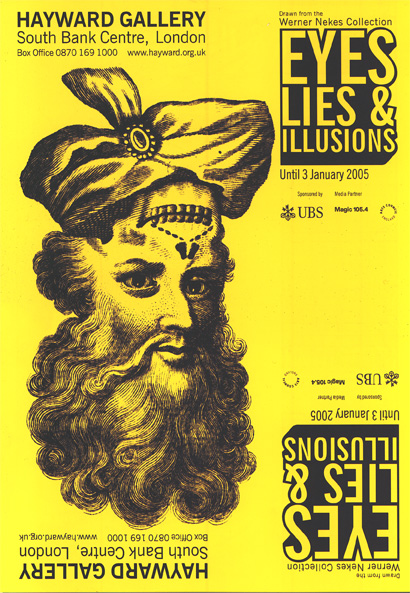"Eyes, Lies & Illusions" Hayward Gallery London
„Magical time out of mind“
by: Jacki Wullschlager
in: Financial Times 06.10.2004
Our eyes are famous for playing tricks with us, and two new exhibitions beckon us into an irresistible history of alternative realities
According to classical fable, a Corinthian girl traced the outline of her lover's shadow cast on a wall, and so made the first fixed human likeness. Millennia later, the new technology of the cinema fulfilled ancient myths about animating statues and bringing images to life. Appearing to recapture lost time, reproducing the unfolding of time itself through the illusion of motion, the 20th-century evolution of shadow pictures changed for ever art's relationship to reality.
"Photography is truth," said Jean-Luc Godard, and, he boasted: "The cinema is truth 24 times per second." From novelty panorama pictures in the 1800s to early cinemas to the IMAX, from boxed television sets in the corner to half-a-wall DVD screens, representations of reality get ever bigger and more real, until they threaten today to destabilise our experience of lived reality and become a substitute for it. How did we get here? asks the Hayward Gallery's new exhibition Eyes, Lies and Illusions. And where do we go on? asks a complementary show, Time Zones, opening at Tate Modern.
In different ways, both shows are caught between nostalgia and modernity. The basis of Eyes, Lies and Illusions is the unique collection of pre-cinematic instruments, images and illusions belonging to the German experimental film-maker Werner Nekes. Displayed to luminous effect - lighting alone is a spectacular ,achievement here - this range of mostly 19th-century magic lanterns and freaky mirrors, camera obscuras and flip-books-cum-peepshows, shadow puppets, prisms, illuminated toy projection-theatres and zoetropes transforms the galleries, corridors and stair wells of the Hayward into an irresistible, unrecognisable enchanted palace of mystery and wonder.
You can enjoy it at the most light-hearted level - the word "illusion" comes from the Latin ludere, to play - or follow it at the most scientific, for deception of the mind is born from understanding it, and with every advance in knowledge about how the brain and eye work, the tricks to slip under their defences and conjure illusions grow more sophisticated. Fascinatingly, we watch the devices here approach modern cinema: Emile Reynaud's 1877 praxinoscope, a rotating device in which the substitution of one image by the next is achieved through prismatic mirrors, leading to his "optical theatre"; Eadweard Muybridge's first successive photographs of galloping horses in 1878; the physiologist Jules-Etienne Marey's 1882 “photographic rifle", a bizarre device held and aimed like a rifle, which contained a photographic mechanism for taking a series of pictures on glass plates.
At the same time, devices across the centuries here embody the thrill of new visions in every sense artistic, psychological, geographical. Magic lanterns gorgeously and ingeniously shaped as the Eiffel Tower, the Taj Mahal, the Buddha, appeared in fin-de-siècle Paris. The painter-psychologist Adalbert Ames designs a walk-in room with sloping chessboard floors, recreated here, which distorts perspective in real space. Marcel Duchamp's hypnotic “rotoreliefs" from the 1930s, with their incessant, whirring drone, anticipate modern games with perspective, such as Ludwig Wilding's stereoscopic pictures, or Carsten Höller's "Punktefilm", where a couple dance in darkness illuminated only by gradually extinguishing points of light representing their joints, like an animated constellation. Anthony McCalls' 1973 "Line Describing a Cone." is a seemingly solid beam of light created from a projected white spot that slowly grows into a complete but ephemeral circle filled with smoke, through which viewers move' about watching one another: a brilliantly simple yet quintessentially 1970s "groupy" work fusing film, sculpture, performance and conceptual art.
The intelligent mix of the present day with the cabinet of curiosities lifts this show into a truly engaging investigation into how and why, even in our image-saturated society, we love to be dazzled. Most memorable of all, Christian Boltanski's shadow-theatres of angels and devils haunt the galleries, circling the walls, concealed in unexpected corners. The silhouette of his feathered, skull-like angel of death, a grotesque version of the child's Christmas angel chime trinket flies malevolently, anti-clockwise, around the opening room reminding us that at root the human quest for animation is surely a desire to suspend and hold the state of being alive, embodying art as death-defying, hinged on the eternal fantasy of immortality. This is a joyous, abundant, life-enhancing show.
So much 20th-century photography and film was about freezing the moment or recreating speed that a reaction is perhaps inevitable in post-modernism's interest in the illusion of slow time. That is the subject of Tate Modem's sorry first exhibition devoted to the moving image, Time Zones, a group show of contemporary international video and film work "which presents the world in real-time or at a slower pace". From buckets filling up with water in an Indonesian back yard in Fiona Tan's disconsolately awful "Rain", to sunlight passing blank aluminium billboards in Albania in Anri Sala's: self-indulgent "Blindfold", this interminable, mind-numbingly slow homage to multicultural banality attempts to shrink the gap between virtual and lived reality to a point where any free-running video of tedium an aeroplane ride away is included.
But wait - a couple of artists here have made exquisitely crafted films that show how artifice, imagination and patience can make thought-provoking, even beautiful work on a theme as abstract as time. The final piece in the show, Francis Alys' "Zocalo", records over 12 hours, the coming and goings on Mexico City's main square, where a central flagpole offers a constantly changing strip of shade: as the sun moves, the line of people standing in the flagpole's shadow shifts around the plaza creating a giant human sundial. And Yang Fudong's "Liu Lan" is a stagy, black-and-white 14minute close-up of the journey of a white-suited man with a briefcase boarding the ancient river-boat belonging to a traditionally dressed young girl: slow time versus fast, old China versus new. These are rare and original things, docu-dramas but also reflections, on the obsession with time and existence that the invention of the moving image helped impose on modernism, and that has shaped our visual culture.

